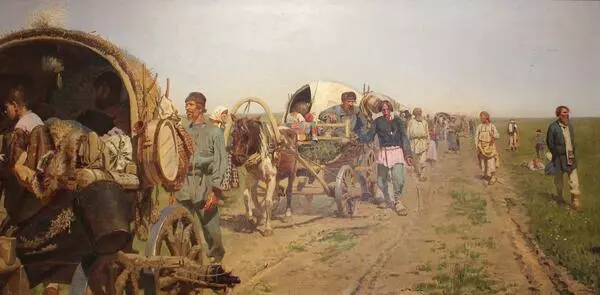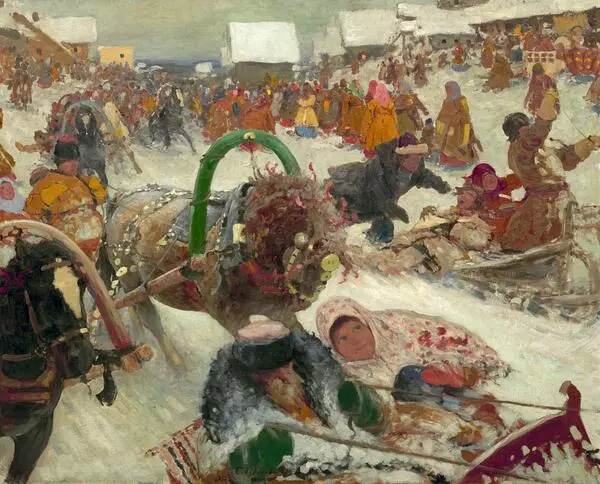The painting ‘In the Forest’ was given to the Art Department of the Tobolsk Provincial Museum by a Peredvizhnik artist, painter, and graphic artist Sergey Ivanov, i.e. by the author himself. One of the goals was to organize the Siberian Art Museum in Tobolsk. On May 27, 1901, after receiving the painting, the first art exhibition was held in the premises of the People’s Audience Hall consisted of the library and halls for exhibitions and concerts.
The idea of the painting “In the Forest” is directly related to the Multan process. Sergey Ivanov first learned about the Multan trial in 1892, i.e. three years later when the second trial was held in Yelabuga. The high-profile trial of falsely accusing the Udmurt peasants of the village of Stary Multan in the Malmyzhskiy district of the Vyatka province of offering human sacrifice to pagan gods has entered the history of Russia. One of the main defenders at the trial was the Russian writer and publicist Vladimir Korolenko. The peasants were acquitted. It was then that Ivanov turned in his work to the topic of foreigners, to the life and religious beliefs of the indigenous Northern peoples of Russia, such as the Zyryans (Komi) and the Votyaks (Udmurts).
According to the plot of the painting, pagans gathered in the clearing. The models for Ivanov were Zyryans, representatives of the Finno-Ugric people, the indigenous population of the Komi and Perm Territory. For the painting, the artist specially created sketches of pagan white clothes with red ornaments, which he dressed the sitters in. The characters gathered around a huge pine tree hung with fur-bearing animal skins symbolized the Creator-God Inmar, to whom the pagan Udmurts prayed during the sacrifice ceremony. On the sacrificial stone, there is a sacrificial bull, from the throat wound of which blood flows into a wooden bucket. In the midst of the rite, a priest appears. Ivanov embodies the image of Metropolitan Stefan of Perm, an Orthodox missionary. In the composition, the pagans are separated from the priest by sacrificial smoke, and he stretches out his hand with a cross through the smoke trying to attract the pagans to talk. Ivanov painted the painting “In the Forest” in memory of Stefan Permskiy and other Orthodox enlighteners.
The plot of the painting, which was started in October 1896, refers the viewer to the 14th century when Christian missionaries addressed pagan tribes with educational sermons. While working, Ivanov studied literary sources and went to the Vyatka province where he visited numerous settlements and supplications of the Udmurts. On the map of the Vyatka province preserved in the archive of the Ivanov family, about 30 points are highlighted. These are the places that he visited.
The idea of the painting “In the Forest” is directly related to the Multan process. Sergey Ivanov first learned about the Multan trial in 1892, i.e. three years later when the second trial was held in Yelabuga. The high-profile trial of falsely accusing the Udmurt peasants of the village of Stary Multan in the Malmyzhskiy district of the Vyatka province of offering human sacrifice to pagan gods has entered the history of Russia. One of the main defenders at the trial was the Russian writer and publicist Vladimir Korolenko. The peasants were acquitted. It was then that Ivanov turned in his work to the topic of foreigners, to the life and religious beliefs of the indigenous Northern peoples of Russia, such as the Zyryans (Komi) and the Votyaks (Udmurts).
According to the plot of the painting, pagans gathered in the clearing. The models for Ivanov were Zyryans, representatives of the Finno-Ugric people, the indigenous population of the Komi and Perm Territory. For the painting, the artist specially created sketches of pagan white clothes with red ornaments, which he dressed the sitters in. The characters gathered around a huge pine tree hung with fur-bearing animal skins symbolized the Creator-God Inmar, to whom the pagan Udmurts prayed during the sacrifice ceremony. On the sacrificial stone, there is a sacrificial bull, from the throat wound of which blood flows into a wooden bucket. In the midst of the rite, a priest appears. Ivanov embodies the image of Metropolitan Stefan of Perm, an Orthodox missionary. In the composition, the pagans are separated from the priest by sacrificial smoke, and he stretches out his hand with a cross through the smoke trying to attract the pagans to talk. Ivanov painted the painting “In the Forest” in memory of Stefan Permskiy and other Orthodox enlighteners.
The plot of the painting, which was started in October 1896, refers the viewer to the 14th century when Christian missionaries addressed pagan tribes with educational sermons. While working, Ivanov studied literary sources and went to the Vyatka province where he visited numerous settlements and supplications of the Udmurts. On the map of the Vyatka province preserved in the archive of the Ivanov family, about 30 points are highlighted. These are the places that he visited.






